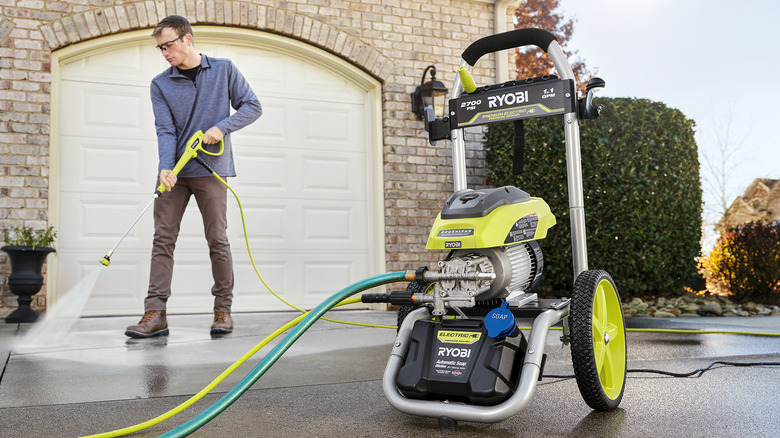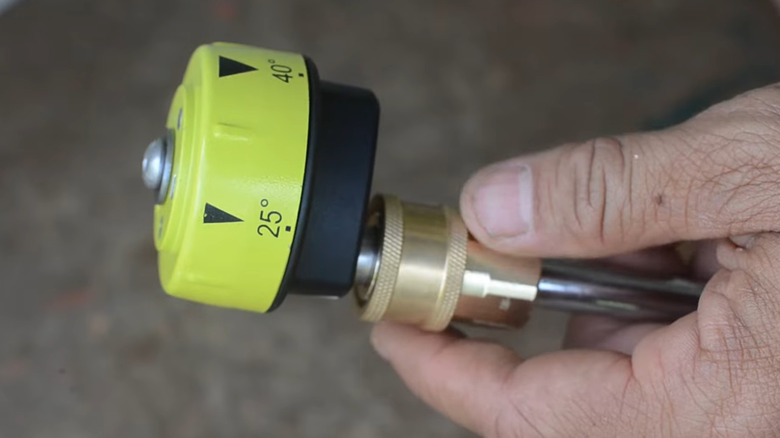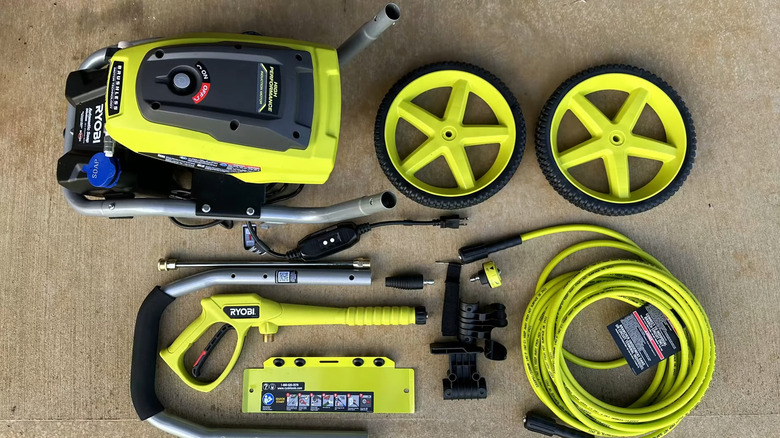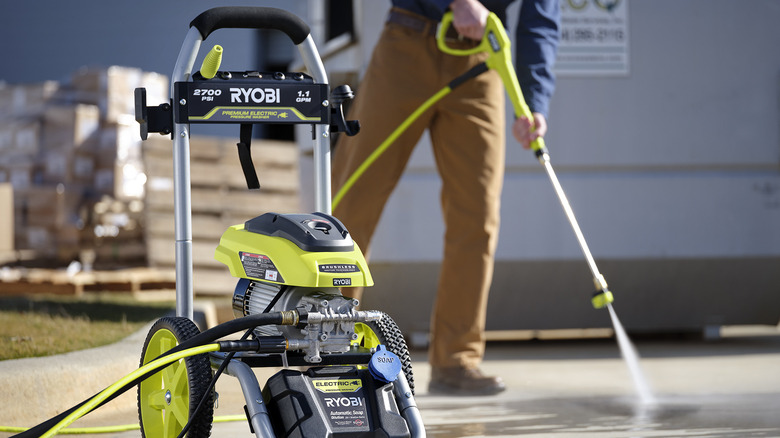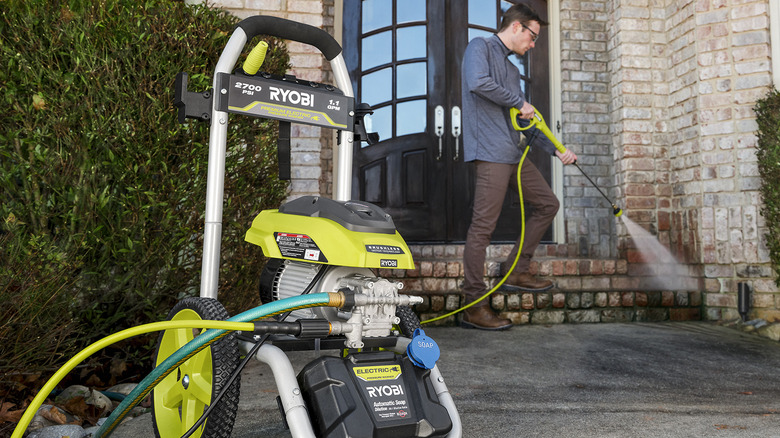The Ryobi 2700 PSI Pressure Washer Has Gone Electric: What To Know Before You Buy
We may receive a commission on purchases made from links.
As much of the tech industry moves toward a more sustainable direction, Ryobi, best-known for its long line of budget-friendly power tools, has jumped on the bandwagon by discontinuing its gas-powered 2700 PSI Pressure Washer. In its place, the 2700 PSI 1.1 GPM Brushless Electric Pressure Washer came on the scene, promising to be a meaner, cleaner, and more versatile machine than ever before. Since then, the company has released electric varieties that go up to 3000 PSI, but that doesn't discount the 2700's many capabilities.
Ryobi is among the best major pressure washer brands out there and this unit lives up to that reputation. Designed with power and efficiency in mind, this pressure washer delivers exceptional cleaning capabilities with its enhanced features such as a 35-foot non-marring pressure hose, a 5-in-1 Quick-Change Nozzle attachment, and a brushless electric motor for a longer-lasting machine. This grab bag of special features means there are endless uses for your Ryobi pressure washer. Whether trying to remove paint on your patio, built-up oil gunking up your driveway, or pollen caking your windows, the Ryobi 2700 Electric Pressure Washer can tackle it all and then some.
It comes with two distinct nozzles
Perhaps the most distinct feature added to the Ryobi 2700 PSI 1.1 GPM Brushless Electric Pressure Washer when compared to its gas-guzzling predecessor, other than being electrically powered, is its unique and versatile nozzle options. Whereas the gas-powered pressure washer came with four different quick-connect nozzles, the electric variety comes with only two — the turbo nozzle and a 5-in-1 pressure washer nozzle.
The cone-shaped turbo nozzle provides you with plenty of power to tackle cleaning concrete, masonry, and similar materials and is advertised with 50% faster cleaning power. The 5-in-1 nozzle attachment, meanwhile, delivers a range of five different pressure washing settings to suit your needs. The 15, 25, or 40-degree settings deliver a higher-pressure wash while the Soap Jet and Soap Fan options are for lower-pressure scenarios. Simply switch between these options by twisting the dial until you land on the setting that works best for you.
These easy-to-access variations are useful and offer unmatched convenience, with less need to switch between a wide range of different nozzles to get the job done. The nozzles attach easily to your spray wand through a quick-connect attachment, the only part of the pressure washer to include this feature.
Assembly isn't especially straightforward
A majority of users have thoroughly enjoyed the Ryobi 2700 PSI 1.1 GPM Brushless Electric Pressure Washer, with the tool sporting a 4.4 out of 5-star rating average on Ryobi's website. But it hasn't been a winner with everyone. Easily the biggest complaint from buyers has been the lack of clear assembly instructions from Ryobi.
Whereas the gas-powered option required no assembly, Ryobi's electric pressure washer does take some time to put together. User @RogerFred shared that Ryobi's vague series of instructions made assembling the pressure washer all the more confusing. "I was a bit disappointed when I took it out of the box and some key assembly components were missing," they shared. "The assembly instructions only provide an illustration to assemble the handle and no information on installing the storage bracket and wheels." Others experienced similar trouble with attaching the wheels, such as @feldie47 who commented, "If you don't know what the washer, stub axle and strangely shaped cotter pin is for, then you may have issues installing the wheels. Does Ryobi think everyone who buys their power washer comes with a mechanic's mindset?"
While many were frustrated by the Ryobi's vagueness, others weren't as bothered. Praising the power tool's ease of use and convenience, user @Stu C also noted that, "No, the instructions aren't the best but if you've put almost anything together in your entire life, you'll be able to figure out the steps that the instructions don't include!" As it seems, your overall experience with assembling similar items will determine how easy piecing this device together will be.
Some design and functionality traits of past models have been left behind
While the Ryobi 2700 PSI 1.1 GPM Brushless Electric Pressure Washer is notable for replacing the gas-powered 2700 PSI model, it's far from the only electric-powered brushless pressure washer available from the company. Its biggest improvement when compared to previous models is its higher pressure capabilities, variable nozzle dial, a more durable wand, and lengthy 35-foot-long hose.
However, in adding such a variety of functions, some features from prior models have been sacrificed. One notable change is that the water inlet and outlet are stacked on top of one another as opposed to being on different sides of the pressure washer, a trait carried from the 2500 pressure washer. This may not be a major concern, but it does run the risk of your cords getting tangled up.
The 2700 pressure washer also lacks the Total Stop feature. This function allows the machine to power off completely as soon as you release the trigger. While the 2700 powers down a little bit, it will still produce audible noise even if you take your hand off the trigger. It's worth noting that the 2300 unit initially harbored these same issues, but these problems were alleviated after receiving an update. Time will tell if the 2700 pressure washer receives similar treatment.
Some additional attachments may be needed
There's no denying the versatility and power of this pressure washer. Its many features and powerful performance make it a perfect choice for anyone seeking a more-than-capable cleaning device for their home. However, it's worth noting some aspects of the Ryobi 2700 PSI 1.1 GPM Brushless Electric Pressure Washer require some out of the box thinking.
You'll quickly learn as you assemble your device that your average Phillip head screwdriver won't do you any good. In order to attach the spray gun storage bracket and nozzle panel attachment to the handle, your screwdriver will need a t30 Torx bit, which doesn't come with the pressure washer itself. As this is not a common screwdriver type owned by most people, some buyers have expressed confusion and frustration over this addition.
This model's hose is 35 feet long and rated for 3300 PSI, a substantial upgrade from prior Ryobi pressure washers. The downside of this appliance is that it can be rather stubborn when it comes to breaking out of its coil shape. As a result, it is prone to kinking if you try to move it rapidly. If you run into this problem, you can easily replace it with a more pliable hose from the likes of brands such as Flexzilla, Flexi Hose, and UberFlex. Keep in mind that your hose will require an M22 connection point or an adapter to successfully attach to the pressure washer. Similarly, having some thread-sealing tape or quick-connect fittings on hand can also be an asset for making it easy to attach and remove attachments to the various hose connections.
